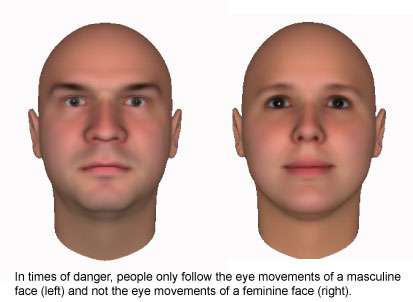In times of danger, people only follow the eye movements of a masculine face (left) and not the eye movements of a feminine face (right).
In the background of evolution, gaze following is one of the oldest manifestations of leadership. Three-month-old babies, for example, already follow the eye movements of their parents. Psychologists at VU University Amsterdam have discovered that in times of danger people follow the eye movements of individuals with a masculine and dominant appearance. When people feel safe, however, they follow the eye movements of both men and women. The results were published yesterday in the scientific journal PLoS One.
VU University psychologists Garian Ohlsen, Wieske van Zoest and Mark van Vugt first showed test subjects pictures of dangerous and non-dangerous situations. Then the researchers investigated whether the subjects followed the eye movements of men or women. The subjects followed the eye movements of both men and women after seeing non-dangerous situations whereas after seeing dangerous situations they followed only the eye movements of men.
"Whether people follow the eye movements of men or women depends on the context in which people perceive those eye movements," says VU University Professor Mark van Vugt. "Apparently in times of danger people are inclined to follow the eye movements of people with a masculine and dominant appearance. People choose to follow dominant leaders in a threatening environment probably because those leaders give them the feeling that their safety is warranted."
More information: The article "Gender and facial dominance in gaze cuing: Emotional context matters in the eyes that we follow" was published yesterday in PLoS One. doi:10.1371/journal.pone.0059471
Journal information: PLoS ONE
Provided by University of Amsterdam




















